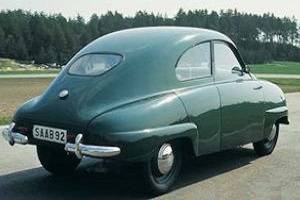Faced with a devastating drop in orders for its aircraft in 1945, Svenska Aeroplan AB (Swedish Aeroplane Limited) needed to diversify; it chose car manufacture. Inspiration came from the popularity of Germany’s DKW cars in Sweden in the 1930s, where their surefooted roadholding suited the country’s treacherous winter roads.

Saab 92 1949
- YEAR REVEALED 1949
- PLACE OF ORIGIN Trollhättan, Sweden
- HISTORICAL STATUS production car
- ENGINE flat two-cylinder, 47ci (764cc)
- MAXIMUM POWER 25bhp
- LAYOUT front-mounted engine driving the front wheels
- BODYWORK two-door four-seater sedan
- TOP SPEED 65mph (105kph)
- NUMBER BUILT 20,128
But improving performance was a key goal; Saab aimed to make their car 50 percent faster by applying aircraft construction methods and aerodynamics. The first prototype took six months to build in 1946. Three years of solid refinement and testing followed until the production lines began rolling on December 12, 1949. Impressively, just 17 percent (by value) of the car consisted of bought-in components.
Named the 92, it was a compact twodoor, four-seater economy sedan with aerodynamic lines. It had a light, strong body built around a passenger “safety cell” and employed torsion bar suspension. The power unit was Saab’s own watercooled two-stroke, a DKW clone mated to a three-speed gearbox with no synchromesh on first.
To overcome the engine’s Achilles heel (oil starvation during engine braking), the transmission featured a freewheel. The 92 was certainly idiosyncratic. It came in just one color, green (gray, blue-grey, and black were added in 1953). The project’s viability was assured when a major distributor pledged to buy 8,000 in exchange for exclusive Swedish sales rights; it soon had a 15,000-strong waiting list.